How to make the perfect tutorial for hardcore gamers and their moms
In this article we want to present you a synopsis of a performance by George Feng - the creator of Plants vs Zombies, a lover of high-fat steaks and rare Magic: The Gathering cards.
George cheerfully and constructively describes the process of creating and integrating a tutorial for his game. And the versatility and simplicity of learning confirms the story of how his mother, who had not come across video games before, went through the entire Plants vs. Zombies and defeated the last boss. George’s main message is: people love to learn, but they don’t always know about it. And when you first met the game, it was the tutorial that was the determining factor in whether the user would play and enjoy the gameplay, or close the game in horror and run away screaming into the horizon.

When George worked on creating Plants vs. Zombies, he asked many times questions: how to make this game as accessible as possible? How to involve people who are not gamers in the game process? And most importantly - how to allow a person to enjoy the learning process? He managed to achieve all of this, and he shares this knowledge with us in the form of 10 rules of a quality tutorial (a tutorial on tutorials).
')

Never separate a tutorial from a game: this will cause the user to fear (or yawn).
The key to success is to try to do everything so that learning does not look like a lesson or lecture at a university. Bad: to call a tutorial a tutorial and separate it from the gameplay. Good: let the user enjoy the learning process. Indeed, in fact, most of the games consist entirely of it - we learn new game mechanics and learn to use them, discover new possibilities and their application. When you learned everything and understood everything - the game stops being fun, right?
George suggests that we make every effort so that the tutorial merges with the gameplay and in no way is there an obstacle between the user and the game — a kind of tametal-chameleon.

The best way to teach a player to perform certain actions is to let him try to carry them out on his own (and not to invite him to read about them). After all, playing is much more fun than just reading about the game.
George explains how this works, using the first level Plants vs. example. Zombies: you should first demonstrate the mechanics to the user (in this case, the polka dots always shoot straight to the right, and the zombies go left), and then immediately give him the opportunity to check whether this is in a friendly and comfortable environment. Another example is a blade in PvZ. George abandoned the idea of text information (did you know that you can use a spatula to replace one plant with another?), Going straight to mini-games using a spatula to clear the entire playing field. The first options coped well with the task of learning, but were boring, and it took time to create such a mini-game that was really fun, and at the same time coped with the task of learning - but it was worth it, because user entertainment is most important.

Do not teach the user to all game mechanics at once! Most likely, it will only alienate him. Ask yourself the question: Does the player need to know about a particular feature right now? And if the answer is no - just postpone the training for later.
Spatula, for example, Plants vs. players. Zombies are only at level 1-5, and the existence of money becomes known only at level 2-1 (10 levels from the beginning of the game!). Access to the store with a choice of upgrades opens up to level 25. George insists that learning should be slow, so that the user gets used to the new (in this case, he realized that in order to expand his capabilities, he would have to save money). In other words - the longer a person plays a game, the greater his desire to grow and learn. Do not give the user new toys while he has not yet played enough with the old ones.

In most cases, as soon as the player performed the action and saw the result (only once!) , He immediately understood exactly how it worked. Sometimes just to highlight the desired object or point at it with an arrow is the most convenient and fast way.
One of the most grandiose tests in creating Plants vs. is associated with this rule. Zombies - "Sunflower dilemma." When testing the game, PopCap faced the fact that many users did not understand how to properly use sunflower and neglected them - which later led to difficulties in passing the levels. But these plants - the most important part of the economy of the game, they produce the "sun" - a resource necessary for growing plants!
George and his colleagues went over a lot of ideas - from changing the economic model to creating separate places on the lawn where only sunflowers could grow, but in the end the problem was solved in a very simple (and cool!) Way:
The cost of sunflower was reduced from 100 suns (peas cost the same) to 50, as well as the starting budget (as much as 200). This was done in order for the user to have the only opportunity to start playing - to plant a sunflower. As we can see, this plant is highlighted in the menu, and the peas remain dark, because our resources are only enough to “purchase” the first - and this is also not accidental: the sunflower will be highlighted by the player twice as often as the peas, reminding about themselves and encouraging them to plant.
According to George, he spotted the illuminated mechanic at the Fisher Price developmental toys for preschoolers, where the child needs to press a lightning object as quickly as possible. And in order to continue to the user still started with sunflower (even if there are other, more affordable plants), the developers added a cooldown to other cheap plants at the beginning of the level - this can be seen in the screenshot.
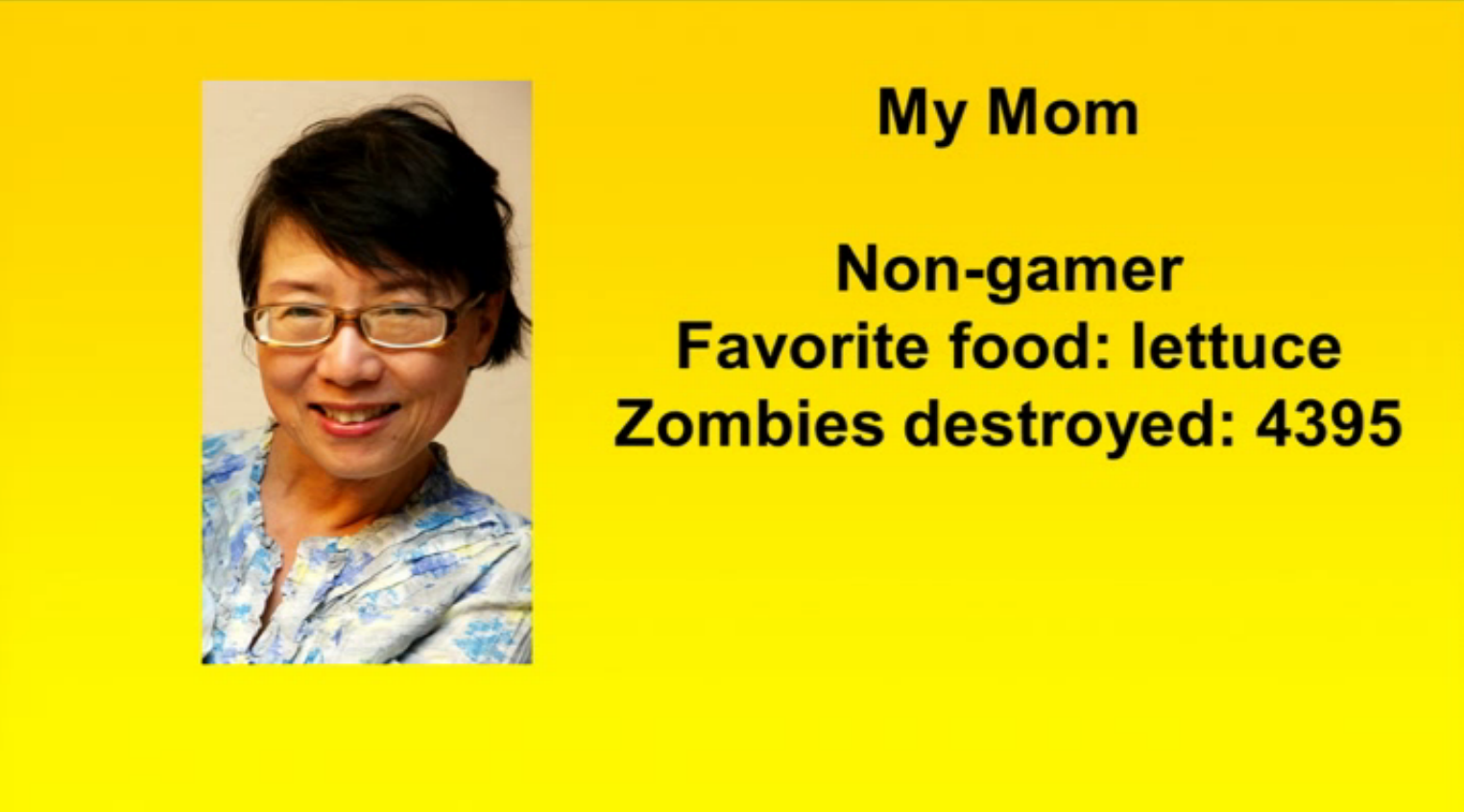
Mom Feng:
- Not a gamer
- Confuses zombies and old men. When I first saw George’s father play Plants vs. Zombies asked: “Why are you killing old people?!?”
- Destroyed 4395 zombies
- Favorite food - lettuce
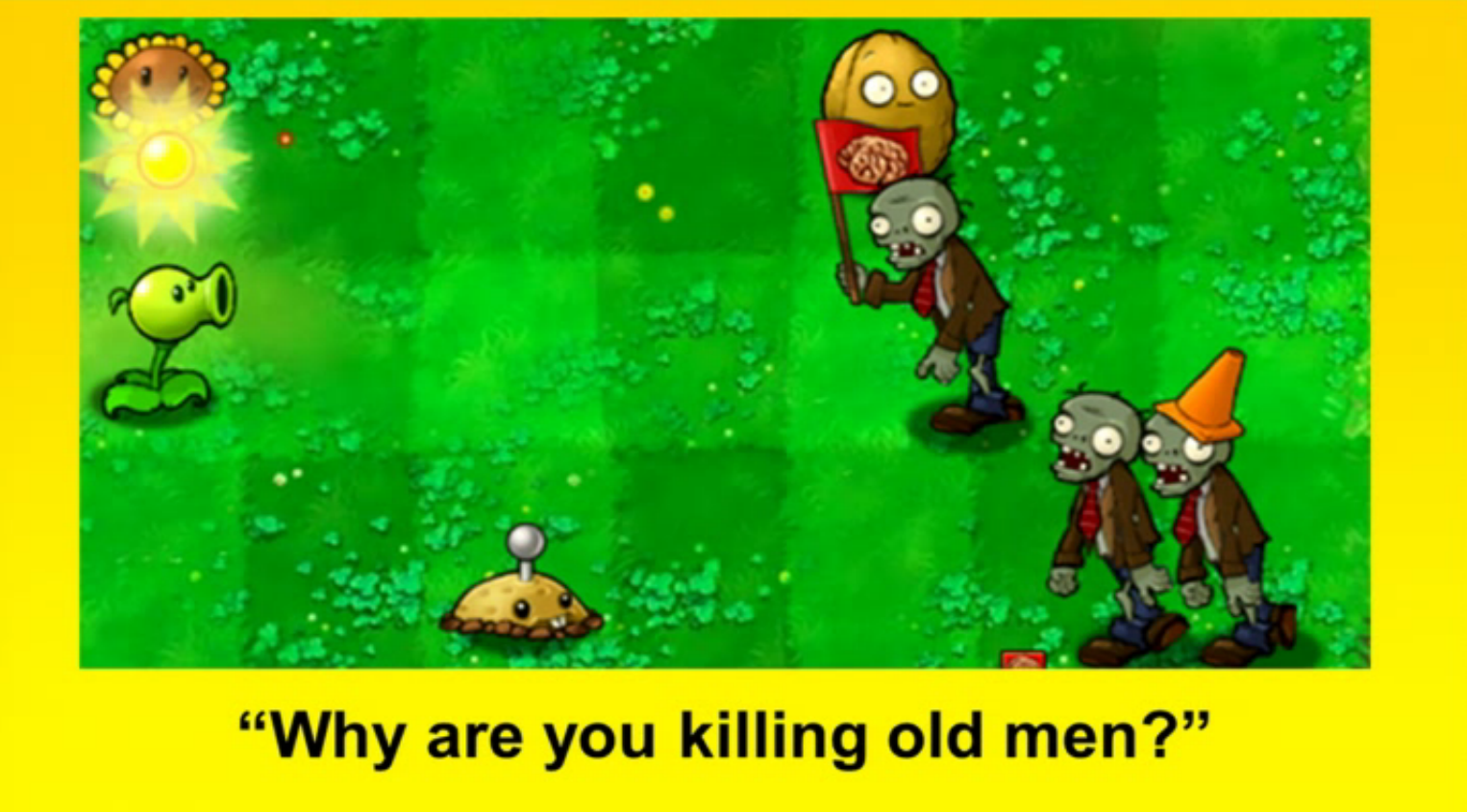
Ideally, strive to ensure that the screen doesn’t have more than 8 words at a time, and the main idea fit in one sentence , rather than split into four.

“Communicate with the player as if you are a“ sophisticated caveman, ” George advises. “You have a shovel!”, “Blow up all the zombies on the map” - briefly, clearly and easily. If a voluminous dialogue cannot be avoided - divide it into several parts, replacing each other.
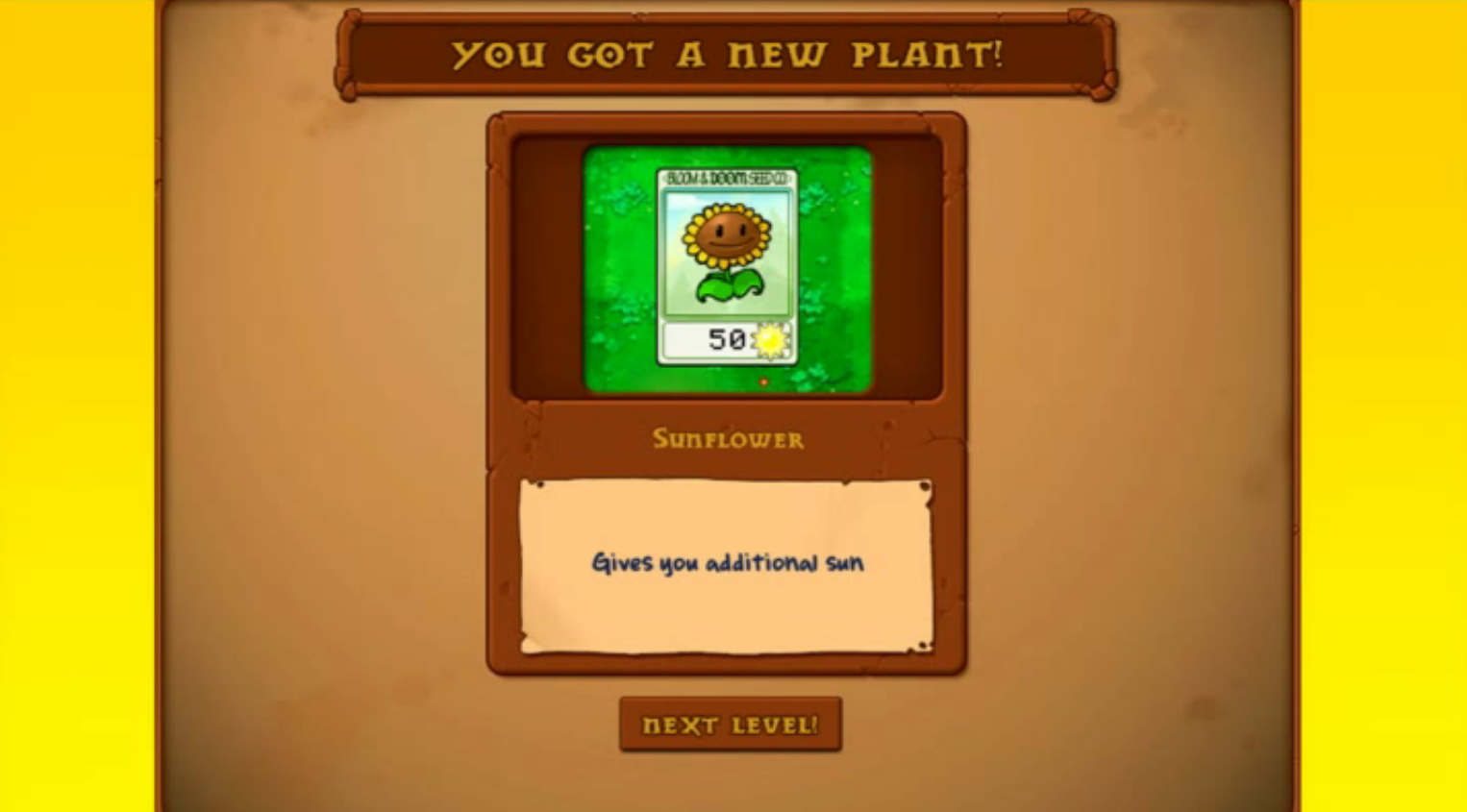
The most important thing in this rule is to understand that it is not worth stopping gameplay for delivering a message (regardless of its degree of importance). Pop-ups - evil! Therefore…
Some users are immediately able to perform the right actions, anticipating our tutorial. But not everyone - and those who are stuck or not fully understood the current game situation need your help in the form of clues that appear specifically for them. The best way to understand how and where to embed such messages is to watch the person playing your game. What details make it difficult for him? What should he pay attention to?
Why you should not show such messages immediately? In order not to scare away hardcore gamers (in the case of Plants vs. Zombies - veterans of Tower Defense games), who immediately act in accordance with their usual pattern of behavior in such games. Experienced players like to feel smart - so give them that opportunity!
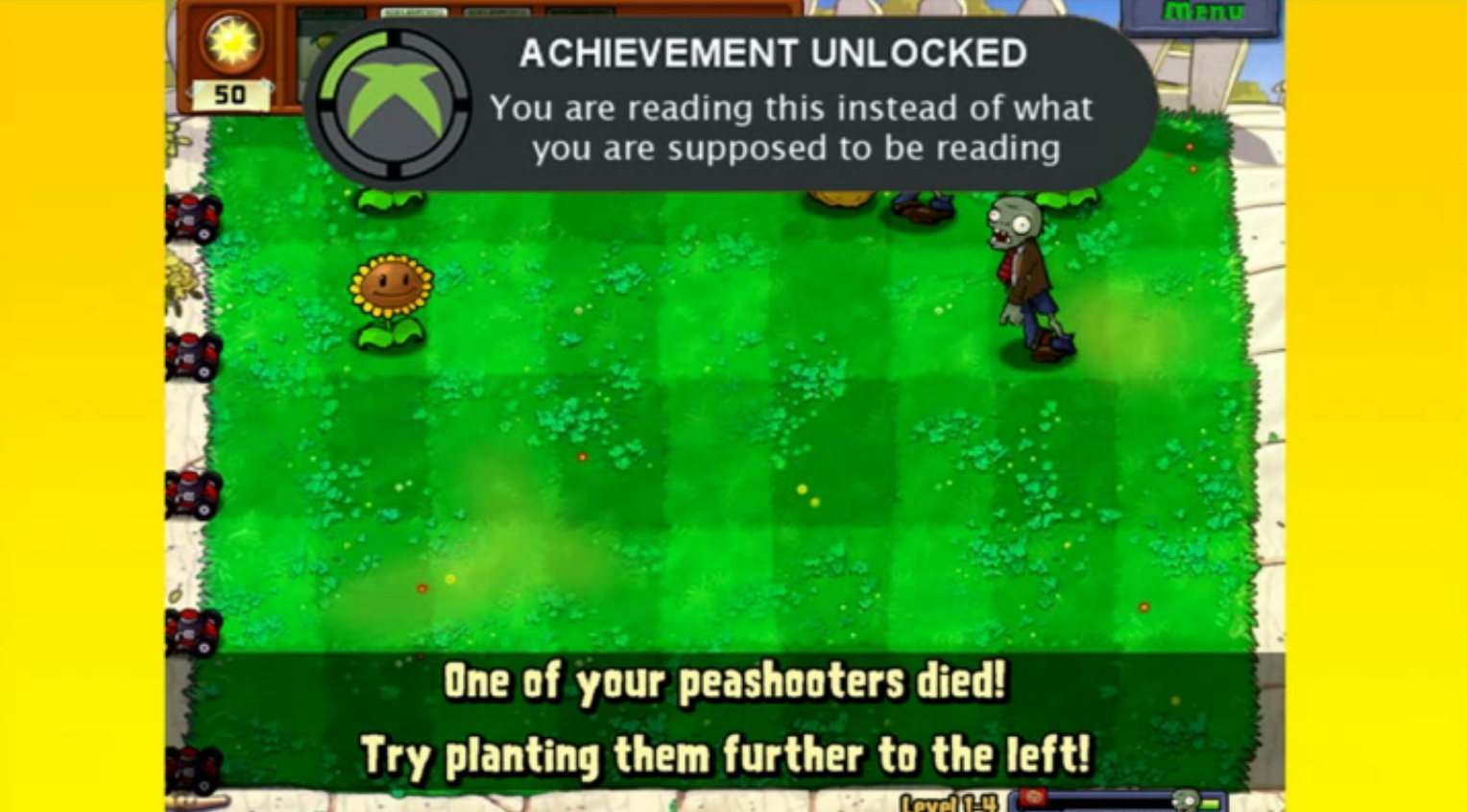
Achivka! You read this text instead of really useful information.
This rule is especially important to observe at the beginning of the game - no need to distract the player from the process of knowing and researching the game! Do not give too much information at once - it will disperse the player’s attention, not allowing him to concentrate on the text / object that is really important to him.

The user already knows what to expect from this plant, as he is familiar with the usual peas, shooting directly at the target.
Your task is to make the gameplay intuitive to facilitate the learning process. The plant should look so that the user can immediately understand how it acts - as with triple peas, for example.
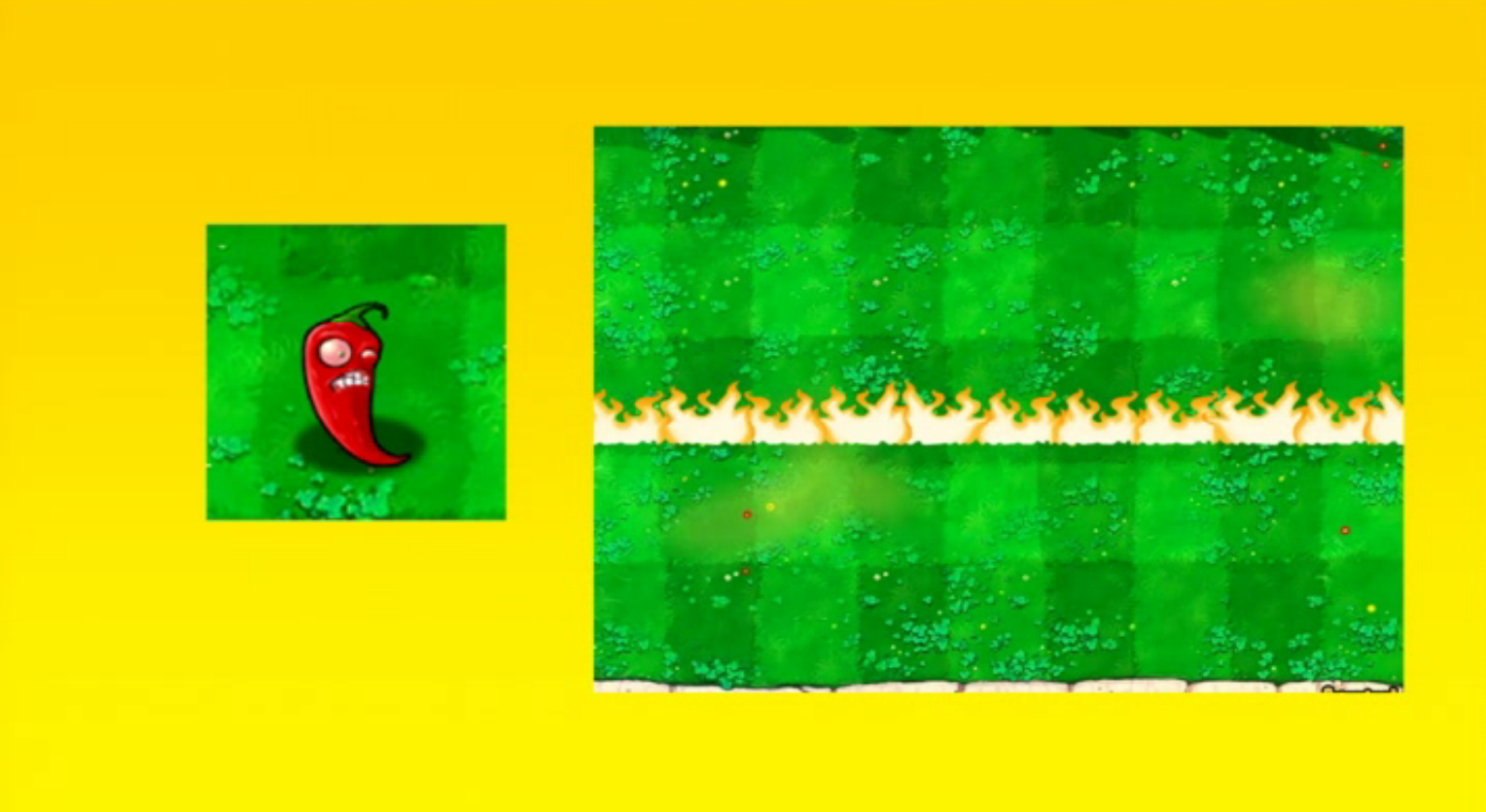
At first, it may not be clear what exactly jalapeno does, but once seeing this fiery strip, the user immediately understands in what cases this plant should be used.
If, however, it is not possible to immediately understand it, then understanding should come immediately, as soon as a new character acts for the first time as a jalapeno pepper.
The knowledge that the future player has acquired in his daily life should also be taken into account - and George explains why. Plants vs. Zombies is a Tower Defense game, and Feng chose plants as “towers”, largely due to the fact that all plants we are used to do not walk, but grow in one place. And zombies are great as enemies - they walk slowly (and most people expect this from them), which saves players from having to move around the playing field - everything fits on one screen. And who wants to put the zombies to his home? The thought about it scares, and the user knows in advance that it should not be allowed in any case!

The same factor applies to the resources in the game - the sun is responsible for the appearance of plants on the field, and the money - for the purchase of upgrades. It seems obvious and simple - isn’t it our goal?
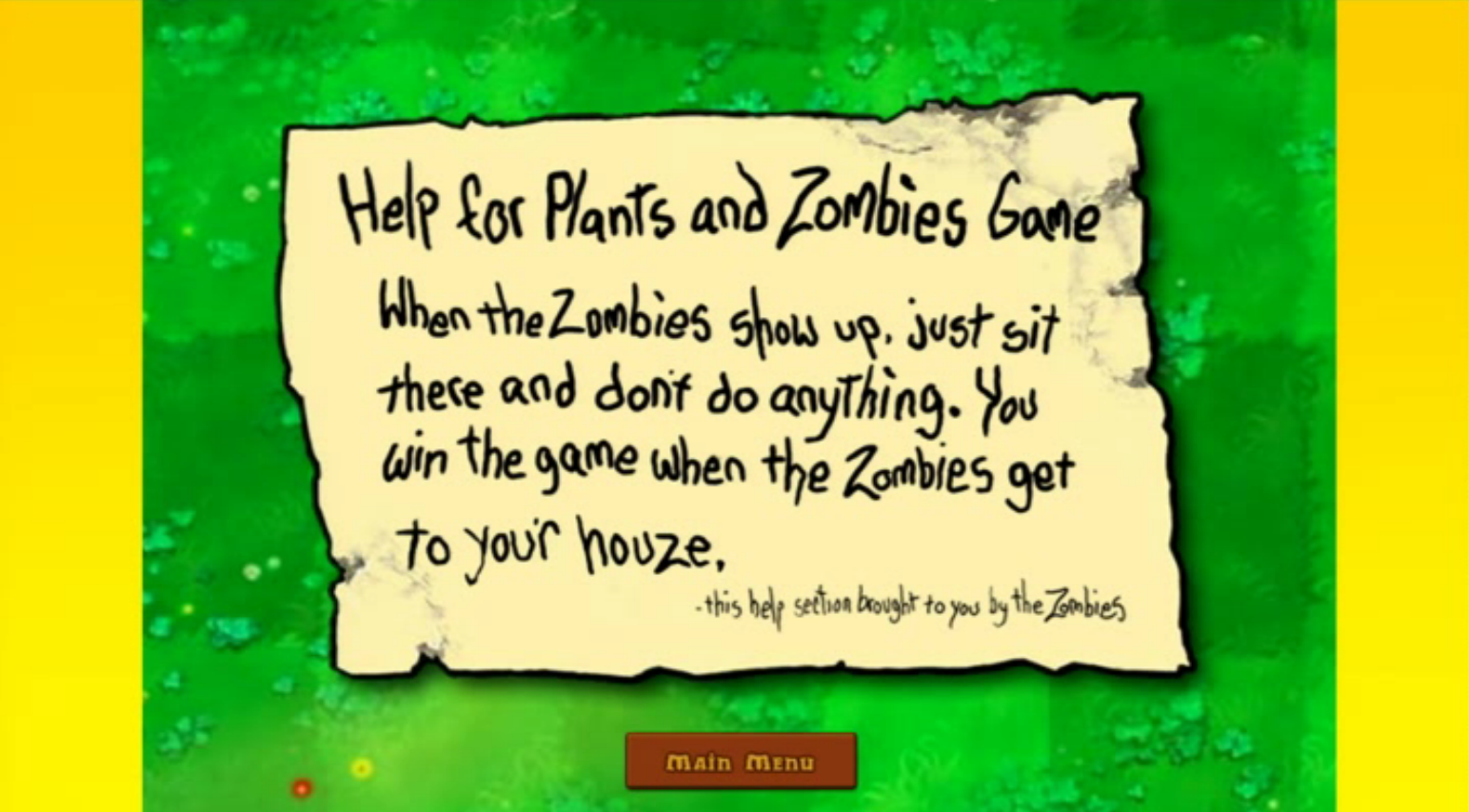
With your tutorial, the user will not need the “Help” section - except for entertainment
On the example of mega successful Plants vs. Zombies George Feng was able not only to clearly demonstrate the need for a “right” tutorial in any game, but also to explain how to integrate simple, intuitive, unobtrusive and extremely effective training that will help non-gamers to quickly adapt and get a lot of gameplay fun , while not blinding the eyes of avid players who "and without these tutorials know everything."

And even if something does not immediately work out - any roughness can be corrected by adding portions of dragons to your game. At least George himself told us so.
Well, in the meantime, we are preparing new articles for translation and we are waiting for you at our open events at GSBI, which will be held this year and next. In particular, this Saturday (December 24) there will be a review lecture on the PC market and mobile games from our friends from Superdata, and on February 11 there will be a whole lecture day , during which representatives of Russian game companies will share their knowledge of game design and game creation basics with guests. Admission is free everywhere, just by registering. Do not forget to pass it.
George cheerfully and constructively describes the process of creating and integrating a tutorial for his game. And the versatility and simplicity of learning confirms the story of how his mother, who had not come across video games before, went through the entire Plants vs. Zombies and defeated the last boss. George’s main message is: people love to learn, but they don’t always know about it. And when you first met the game, it was the tutorial that was the determining factor in whether the user would play and enjoy the gameplay, or close the game in horror and run away screaming into the horizon.

So what is the secret of the perfect tutorial?
When George worked on creating Plants vs. Zombies, he asked many times questions: how to make this game as accessible as possible? How to involve people who are not gamers in the game process? And most importantly - how to allow a person to enjoy the learning process? He managed to achieve all of this, and he shares this knowledge with us in the form of 10 rules of a quality tutorial (a tutorial on tutorials).
')

Never separate a tutorial from a game: this will cause the user to fear (or yawn).
Rule one: the tutorial should be integrated into the gameplay.
The key to success is to try to do everything so that learning does not look like a lesson or lecture at a university. Bad: to call a tutorial a tutorial and separate it from the gameplay. Good: let the user enjoy the learning process. Indeed, in fact, most of the games consist entirely of it - we learn new game mechanics and learn to use them, discover new possibilities and their application. When you learned everything and understood everything - the game stops being fun, right?
George suggests that we make every effort so that the tutorial merges with the gameplay and in no way is there an obstacle between the user and the game — a kind of tametal-chameleon.
Rule two: less words - more things!
The best way to teach a player to perform certain actions is to let him try to carry them out on his own (and not to invite him to read about them). After all, playing is much more fun than just reading about the game.
George explains how this works, using the first level Plants vs. example. Zombies: you should first demonstrate the mechanics to the user (in this case, the polka dots always shoot straight to the right, and the zombies go left), and then immediately give him the opportunity to check whether this is in a friendly and comfortable environment. Another example is a blade in PvZ. George abandoned the idea of text information (did you know that you can use a spatula to replace one plant with another?), Going straight to mini-games using a spatula to clear the entire playing field. The first options coped well with the task of learning, but were boring, and it took time to create such a mini-game that was really fun, and at the same time coped with the task of learning - but it was worth it, because user entertainment is most important.

Rule three: distribute training throughout the gameplay.
Do not teach the user to all game mechanics at once! Most likely, it will only alienate him. Ask yourself the question: Does the player need to know about a particular feature right now? And if the answer is no - just postpone the training for later.
Spatula, for example, Plants vs. players. Zombies are only at level 1-5, and the existence of money becomes known only at level 2-1 (10 levels from the beginning of the game!). Access to the store with a choice of upgrades opens up to level 25. George insists that learning should be slow, so that the user gets used to the new (in this case, he realized that in order to expand his capabilities, he would have to save money). In other words - the longer a person plays a game, the greater his desire to grow and learn. Do not give the user new toys while he has not yet played enough with the old ones.

Rule number four: one time will be enough.
In most cases, as soon as the player performed the action and saw the result (only once!) , He immediately understood exactly how it worked. Sometimes just to highlight the desired object or point at it with an arrow is the most convenient and fast way.
One of the most grandiose tests in creating Plants vs. is associated with this rule. Zombies - "Sunflower dilemma." When testing the game, PopCap faced the fact that many users did not understand how to properly use sunflower and neglected them - which later led to difficulties in passing the levels. But these plants - the most important part of the economy of the game, they produce the "sun" - a resource necessary for growing plants!
George and his colleagues went over a lot of ideas - from changing the economic model to creating separate places on the lawn where only sunflowers could grow, but in the end the problem was solved in a very simple (and cool!) Way:
The cost of sunflower was reduced from 100 suns (peas cost the same) to 50, as well as the starting budget (as much as 200). This was done in order for the user to have the only opportunity to start playing - to plant a sunflower. As we can see, this plant is highlighted in the menu, and the peas remain dark, because our resources are only enough to “purchase” the first - and this is also not accidental: the sunflower will be highlighted by the player twice as often as the peas, reminding about themselves and encouraging them to plant.
According to George, he spotted the illuminated mechanic at the Fisher Price developmental toys for preschoolers, where the child needs to press a lightning object as quickly as possible. And in order to continue to the user still started with sunflower (even if there are other, more affordable plants), the developers added a cooldown to other cheap plants at the beginning of the level - this can be seen in the screenshot.

Mom Feng:
- Not a gamer
- Confuses zombies and old men. When I first saw George’s father play Plants vs. Zombies asked: “Why are you killing old people?!?”
- Destroyed 4395 zombies
- Favorite food - lettuce

Rule number five: a lot of text is bad.
Ideally, strive to ensure that the screen doesn’t have more than 8 words at a time, and the main idea fit in one sentence , rather than split into four.

“Communicate with the player as if you are a“ sophisticated caveman, ” George advises. “You have a shovel!”, “Blow up all the zombies on the map” - briefly, clearly and easily. If a voluminous dialogue cannot be avoided - divide it into several parts, replacing each other.

The sixth rule: build communication unobtrusively.
The most important thing in this rule is to understand that it is not worth stopping gameplay for delivering a message (regardless of its degree of importance). Pop-ups - evil! Therefore…
Rule number seven: use responsive messages.
Some users are immediately able to perform the right actions, anticipating our tutorial. But not everyone - and those who are stuck or not fully understood the current game situation need your help in the form of clues that appear specifically for them. The best way to understand how and where to embed such messages is to watch the person playing your game. What details make it difficult for him? What should he pay attention to?
Why you should not show such messages immediately? In order not to scare away hardcore gamers (in the case of Plants vs. Zombies - veterans of Tower Defense games), who immediately act in accordance with their usual pattern of behavior in such games. Experienced players like to feel smart - so give them that opportunity!

Achivka! You read this text instead of really useful information.
Rule eight: do not need extra noise.
This rule is especially important to observe at the beginning of the game - no need to distract the player from the process of knowing and researching the game! Do not give too much information at once - it will disperse the player’s attention, not allowing him to concentrate on the text / object that is really important to him.

The user already knows what to expect from this plant, as he is familiar with the usual peas, shooting directly at the target.
Rule Nine: Use visualization when learning.
Your task is to make the gameplay intuitive to facilitate the learning process. The plant should look so that the user can immediately understand how it acts - as with triple peas, for example.

At first, it may not be clear what exactly jalapeno does, but once seeing this fiery strip, the user immediately understands in what cases this plant should be used.
If, however, it is not possible to immediately understand it, then understanding should come immediately, as soon as a new character acts for the first time as a jalapeno pepper.
Rule Ten: Consider the user's “knowledge base”.
The knowledge that the future player has acquired in his daily life should also be taken into account - and George explains why. Plants vs. Zombies is a Tower Defense game, and Feng chose plants as “towers”, largely due to the fact that all plants we are used to do not walk, but grow in one place. And zombies are great as enemies - they walk slowly (and most people expect this from them), which saves players from having to move around the playing field - everything fits on one screen. And who wants to put the zombies to his home? The thought about it scares, and the user knows in advance that it should not be allowed in any case!

The same factor applies to the resources in the game - the sun is responsible for the appearance of plants on the field, and the money - for the purchase of upgrades. It seems obvious and simple - isn’t it our goal?

With your tutorial, the user will not need the “Help” section - except for entertainment
What have we learned?
On the example of mega successful Plants vs. Zombies George Feng was able not only to clearly demonstrate the need for a “right” tutorial in any game, but also to explain how to integrate simple, intuitive, unobtrusive and extremely effective training that will help non-gamers to quickly adapt and get a lot of gameplay fun , while not blinding the eyes of avid players who "and without these tutorials know everything."

And even if something does not immediately work out - any roughness can be corrected by adding portions of dragons to your game. At least George himself told us so.
Well, in the meantime, we are preparing new articles for translation and we are waiting for you at our open events at GSBI, which will be held this year and next. In particular, this Saturday (December 24) there will be a review lecture on the PC market and mobile games from our friends from Superdata, and on February 11 there will be a whole lecture day , during which representatives of Russian game companies will share their knowledge of game design and game creation basics with guests. Admission is free everywhere, just by registering. Do not forget to pass it.
Source: https://habr.com/ru/post/317918/
All Articles